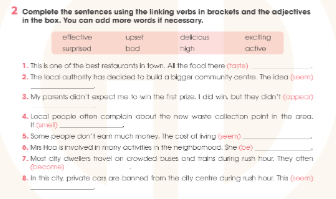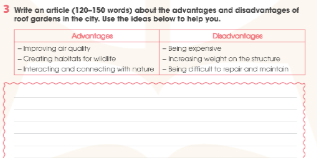Sách bài tập Tiếng Anh 11 Global Success Unit 3 Writing
SBT Tiếng Anh 11 Unit 3 Writing Global success
Nằm trong bộ tài liệu Giải tiếng Anh 11 Kết nối tri thức theo từng Unit, Soạn tiếng Anh 11 Unit 3 Cities of the future Writing giúp các em chuẩn bị bài tập SBT tiếng Anh hiệu quả.
Sách bài tập Tiếng Anh 11 Global Success Unit 3 Writing
Bản quyền thuộc về VnDoc nghiêm cấm mọi hành vi sao chép vì mục đích thương mại
1. Use the words and phrases below, and add some words where necessary to make meaningful sentences. Change the verb form if necessary.
(Sử dụng từ và các cụm từ dưới đây, và thêm một số từ vào chỗ cần thiết để tạo các câu hoàn chỉnh. Thay đổi dạng động từ nếu cần)
1. Build / smart city / seem / impossible / 50 years / ago.
2. I / not think / live / smart city / good / everyone.
3. art museum building / look / impressive / a distance.
4. great thing about / live / smart city / be / very / safe.
5. Since / the first driverless railway / open / Japan / 1981, driverless trains / become popular / world.
6. city tour, / including / visit / new twin towers. / sound / inferest.
7. City dwellers / can easily / book / parking lot / use / a mobile app.
8. My parents / think / buy / new / house / outside / city.
Gợi ý đáp án
1. Building a smart city seemed impossible 50 years ago.
2. I don’t think living in a smart city is good for everyone.
3. The art museum building looks impressive from a distance.
4. The great thing about living a smart city is that is very safe.
5. Since the first driveless railway opened in Japan in 1981, diverless trains have become popular around/ all over the world.
6. The city tour, including the visit to the new twin towers, sounds interesting.
7. City dwellers can easily book a parking lot (by) using a mobile app.
8. My parents are thinking of buying a new house outside the city.
Hướng dẫn dịch
1. Xây dựng thành phố thông minh dường như bất khả thi 50 năm trước
2. Tôi không nghĩ rằng sống trong một thành phố thông minh là tốt cho tất cả mọi người.
3. Tòa nhà bảo tàng nghệ thuật nhìn từ xa rất ấn tượng.
4. Điều tuyệt vời khi sống trong một thành phố thông minh là nó rất an toàn.
5. Kể từ khi tuyến đường sắt không người lái đầu tiên được mở tại Nhật Bản vào năm 1981, các chuyến tàu không người lái đã trở nên phổ biến trên toàn thế giới.
6. Chuyến tham quan thành phố, bao gồm cả chuyến thăm tòa tháp đôi mới, nghe có vẻ thú vị.
7. Cư dân thành phố có thể dễ dàng đặt chỗ đậu xe (bằng cách) sử dụng ứng dụng di động.
8. Bố mẹ tôi đang nghĩ đến việc mua một ngôi nhà mới ở ngoài thành phố.
2. Complete the sentences using the linking verbs in bracket and the adjectives in the box. You can add more words if necessary.
(Hoàn thành các câu sử dụng động từ nối trong ngoặc và tính từ trong hộp. Bạn có thể thêm từ nếu cần)

Gợi ý đáp án
1. All the food there tastes (very) delicious.
2. The idea seems exciting (for many people)
3. I did win, but they didn’t appear (at all) supported.
4. It smells (very) bad.
5. The cost of living seems (very) high (for them)
6. She is (very) active.
7. They often become upset about the delays/ traffic jams and crowded trains.
8. This seems effective in preventing traffic jams/ improving the air quality.
Hướng dẫn dịch
1. Tất cả thức ăn ở đó đều có vị (rất) ngon.
2. Ý tưởng có vẻ thú vị (đối với nhiều người).
3. Tôi đã thắng, nhưng họ không tỏ ra (hoàn toàn) ngạc nhiên.
4. Nếu có mùi (rất) khó chịu.
5. Chi phí sinh hoạt có vẻ (rất) cao (đối với họ).
6. Cô ấy (rất) năng động.
7. Họ thường khó chịu về sự chậm trễ/tắc đường và những chuyến tàu đông đúc.
8. Điều này có vẻ hiệu quả trong việc ngăn chặn tắc đường/cải thiện chất lượng không khí.
3. Write an article (120-150 words) about the advantages and disadvantages of roof gardens in the city. Use the ideas below to help you.
(Viết một bài báo (120-150 từ) về những ưu điểm và nhược điểm của vườn trên gác mái ở thành phố. Sử dụng những ý tưởng dưới đây để giúp bạn.)

Gợi ý đáp án
Roof gardens have become very popular in big cities, and they are definitely the future of city architecture. So, what are their advantages and disadvantages? On the one hand, roof gardens improve air quality in cities. Plants naturally absorb carbon dioxide and release oxygen back into the air. In crowded areas, roof gardens help reduce air pollution by filtering harmful gases. Roof gardens can also become new habitats for wildlife. For example, they can provide water, food, and even cover for birds. On the other hand, roof gardens are expensive. Since the construction and maintenance are difficult, and the materials are not easily found, it is hard for people to afford them. Besides, they add more weight to a building, which may cause problems for the whole structure, especially in storms or other unfavourable weather conditions. In short, there are both pros and cons of roof gardens. Such gardens can be further developed in the future, but the disadvantages should be considered to reduce the risk to life and property.
Bài dịch
Những khu vườn trên mái đã trở nên rất phổ biến ở các thành phố lớn, và chúng chắc chắn là tương lai của kiến trúc thành phố. Vì vậy, những lợi thế và bất lợi của họ là gì? Một mặt, vườn trên mái cải thiện chất lượng không khí ở các thành phố. Thực vật hấp thụ carbon dioxide một cách tự nhiên và giải phóng oxy trở lại không khí. Ở những khu vực đông đúc, vườn trên mái giúp giảm ô nhiễm không khí bằng cách lọc khí độc hại. Vườn trên mái cũng có thể trở thành môi trường sống mới cho động vật hoang dã. Ví dụ, chúng có thể cung cấp nước, thức ăn và thậm chí là nơi trú ẩn cho các loài chim. Mặt khác, những khu vườn trên mái rất tốn kém. Vì việc xây dựng và bảo trì khó khăn, và vật liệu không dễ kiếm nên người dân khó có thể mua được. Bên cạnh đó, chúng làm tăng thêm trọng lượng cho công trình, có thể gây ra các vấn đề cho toàn bộ công trình, đặc biệt là khi có bão hoặc các điều kiện thời tiết bất lợi khác. Nói tóm lại, có cả ưu và nhược điểm của vườn trên mái. Những khu vườn như vậy có thể được phát triển hơn nữa trong tương lai, nhưng những nhược điểm cần được xem xét để giảm rủi ro đối với tính mạng và tài sản.
Tham khảo thêm: Write an article (120-150 words) about the advantages and disadvantages of roof gardens in the city
Trên đây là Soạn tiếng Anh 11 Global Success Unit 3 Writing đầy đủ nhất.








